人教版(PEP)四年级下册Recycle2教学设计(共3课时)
文档属性
| 名称 | 人教版(PEP)四年级下册Recycle2教学设计(共3课时) | 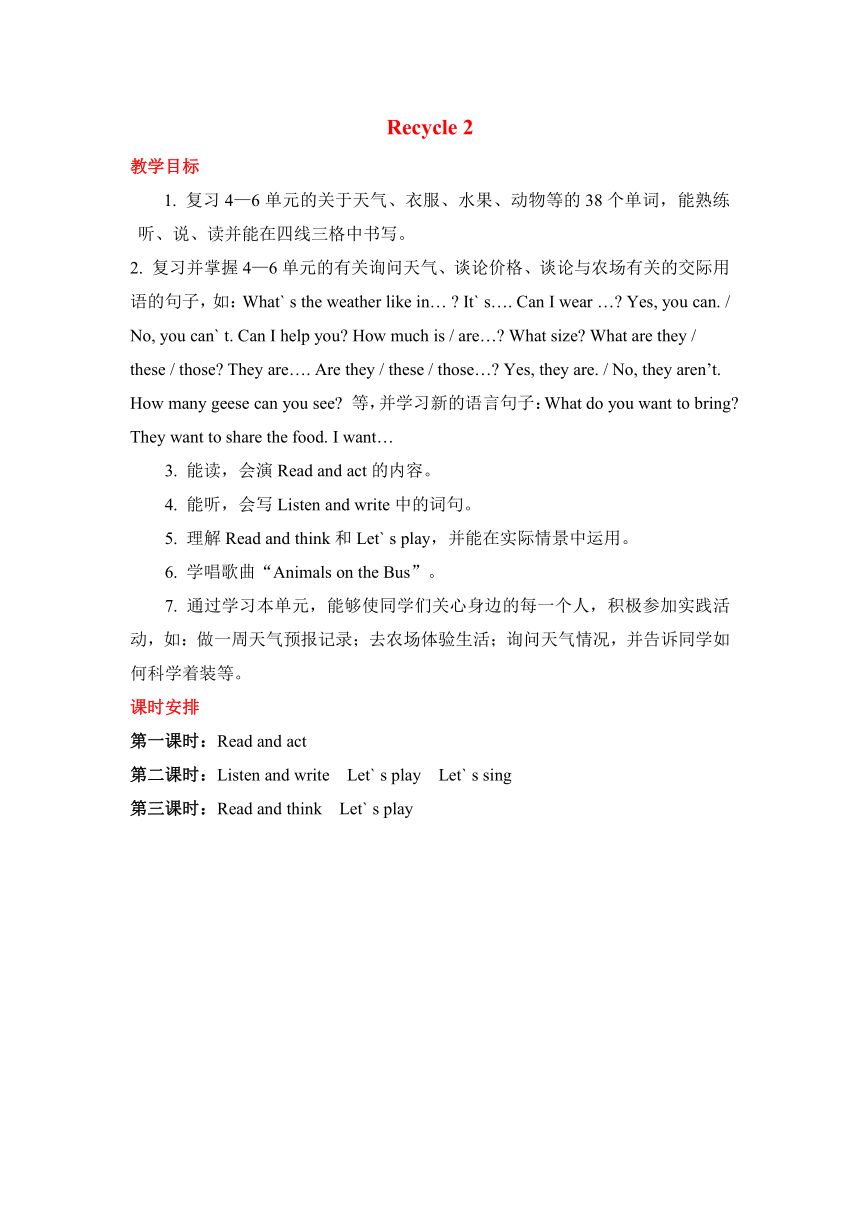 | |
| 格式 | zip | ||
| 文件大小 | 578.2KB | ||
| 资源类型 | 教案 | ||
| 版本资源 | 人教版(PEP) | ||
| 科目 | 英语 | ||
| 更新时间 | 2011-12-17 14:50:08 | ||
图片预览

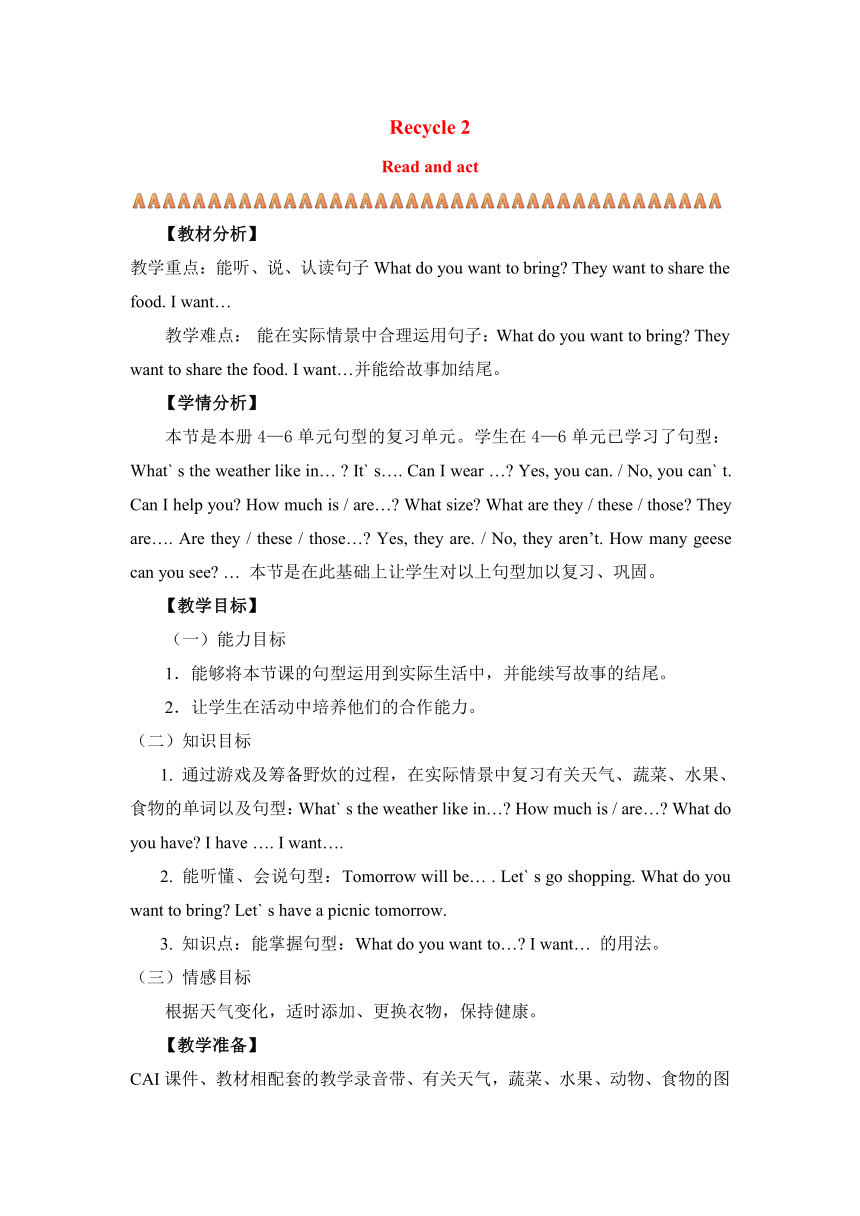
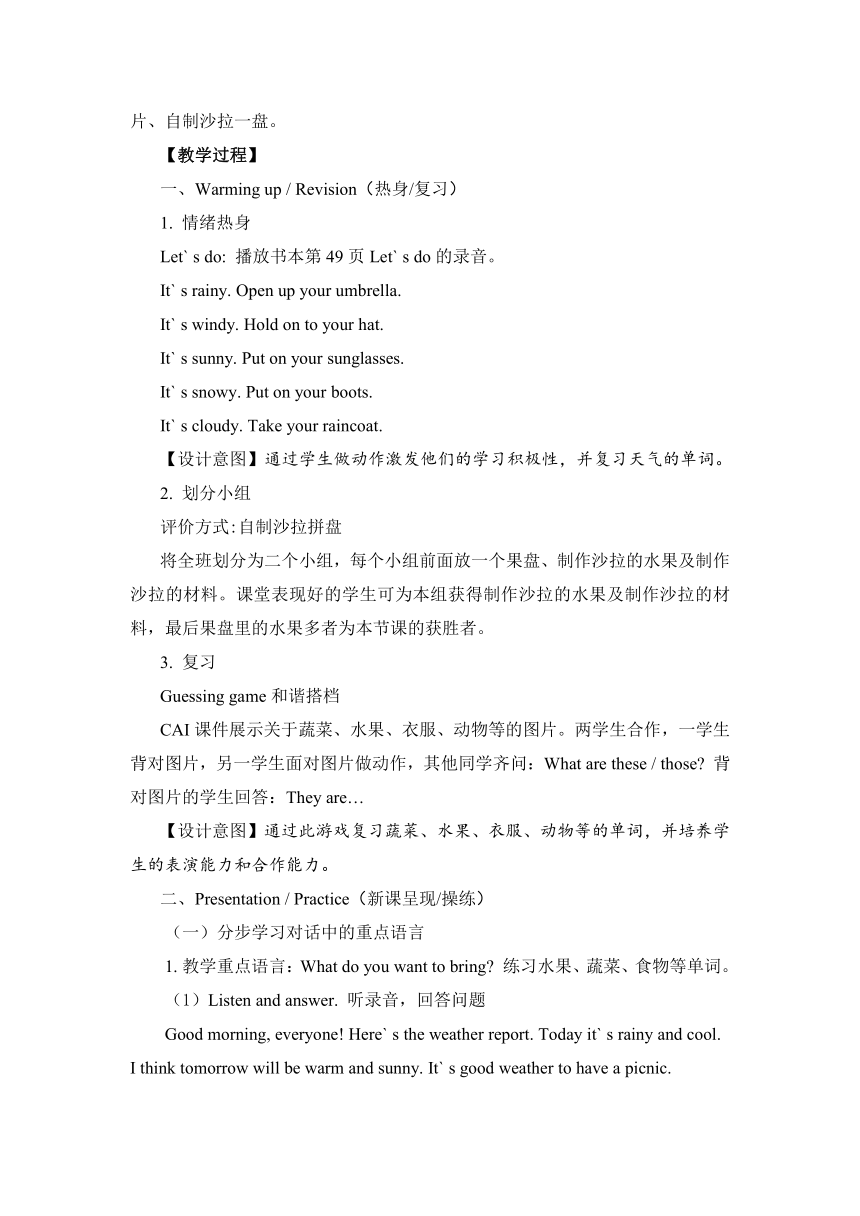
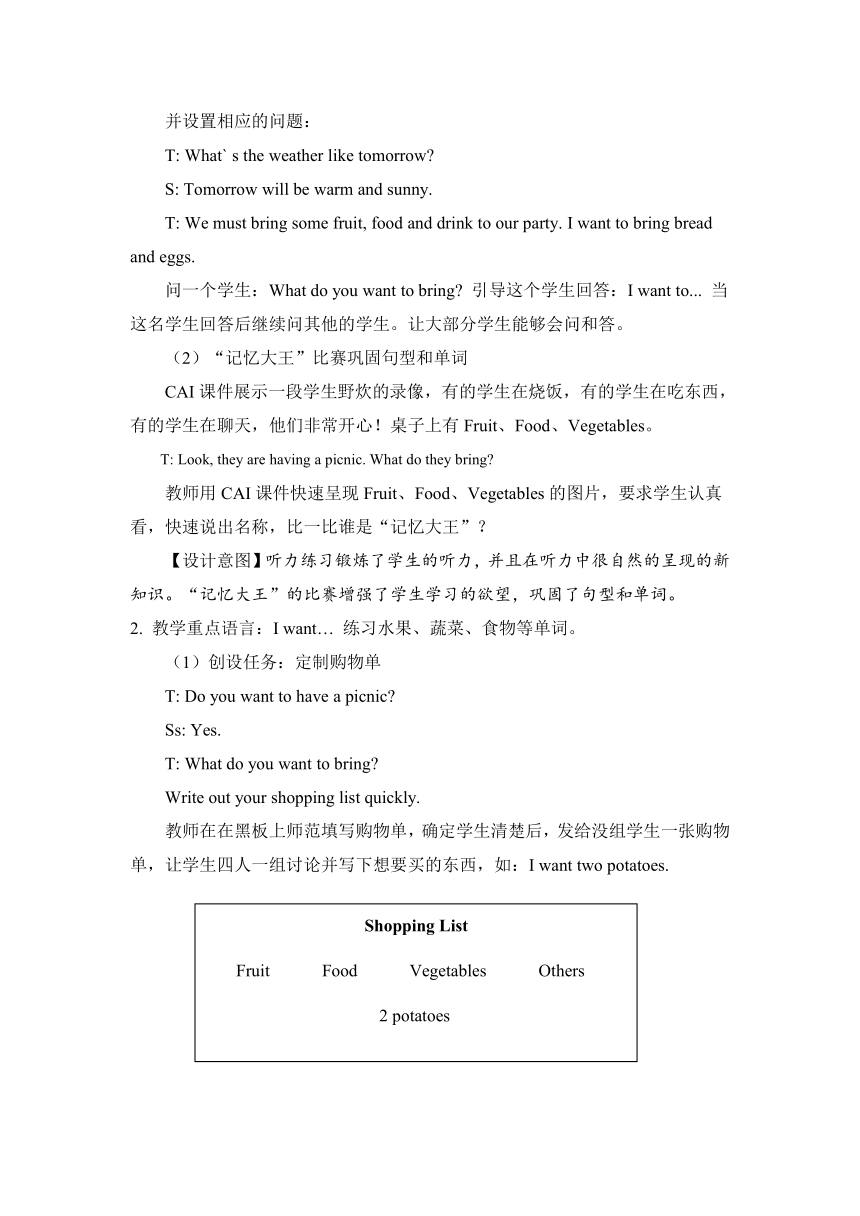
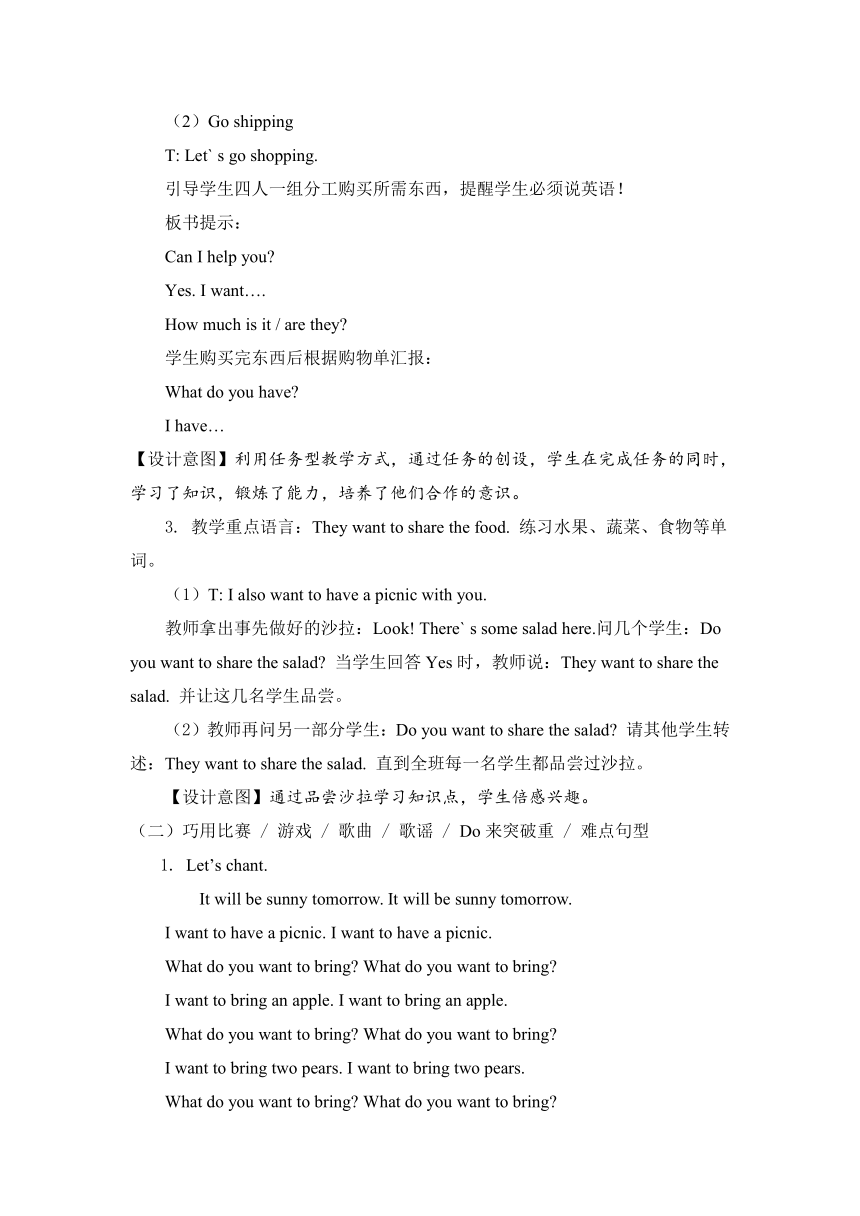
文档简介
Recycle 2
教学目标
1. 复习4—6单元的关于天气、衣服、水果、动物等的38个单词,能熟练听、说、读并能在四线三格中书写。
2. 复习并掌握4—6单元的有关询问天气、谈论价格、谈论与农场有关的交际用语的句子,如:What` s the weather like in… It` s…. Can I wear … Yes, you can. / No, you can` t. Can I help you How much is / are… What size What are they / these / those They are…. Are they / these / those… Yes, they are. / No, they aren’t. How many geese can you see 等,并学习新的语言句子:What do you want to bring They want to share the food. I want…
3. 能读,会演Read and act的内容。
4. 能听,会写Listen and write中的词句。
5. 理解Read and think和Let` s play,并能在实际情景中运用。
6. 学唱歌曲“Animals on the Bus”。
7. 通过学习本单元,能够使同学们关心身边的每一个人,积极参加实践活动,如:做一周天气预报记录;去农场体验生活;询问天气情况,并告诉同学如何科学着装等。
课时安排
第一课时:Read and act
第二课时:Listen and write Let` s play Let` s sing
第三课时:Read and think Let` s play
Recycle 2
Read and act
【教材分析】
教学重点:能听、说、认读句子What do you want to bring They want to share the food. I want…
教学难点: 能在实际情景中合理运用句子:What do you want to bring They want to share the food. I want…并能给故事加结尾。
【学情分析】
本节是本册4—6单元句型的复习单元。学生在4—6单元已学习了句型:What` s the weather like in… It` s…. Can I wear … Yes, you can. / No, you can` t. Can I help you How much is / are… What size What are they / these / those They are…. Are they / these / those… Yes, they are. / No, they aren’t. How many geese can you see … 本节是在此基础上让学生对以上句型加以复习、巩固。
【教学目标】
(一)能力目标
1.能够将本节课的句型运用到实际生活中,并能续写故事的结尾。
2.让学生在活动中培养他们的合作能力。
(二)知识目标
1. 通过游戏及筹备野炊的过程,在实际情景中复习有关天气、蔬菜、水果、食物的单词以及句型:What` s the weather like in… How much is / are… What do you have I have …. I want….
2. 能听懂、会说句型:Tomorrow will be… . Let` s go shopping. What do you want to bring Let` s have a picnic tomorrow.
3. 知识点:能掌握句型:What do you want to… I want… 的用法。
(三)情感目标
根据天气变化,适时添加、更换衣物,保持健康。
【教学准备】
CAI课件、教材相配套的教学录音带、有关天气,蔬菜、水果、动物、食物的图片、自制沙拉一盘。
【教学过程】
一、Warming up / Revision(热身/复习)
1. 情绪热身
Let` s do: 播放书本第49页Let` s do的录音。
It` s rainy. Open up your umbrella.
It` s windy. Hold on to your hat.
It` s sunny. Put on your sunglasses.
It` s snowy. Put on your boots.
It` s cloudy. Take your raincoat.
【设计意图】通过学生做动作激发他们的学习积极性,并复习天气的单词。
2. 划分小组
评价方式:自制沙拉拼盘
将全班划分为二个小组,每个小组前面放一个果盘、制作沙拉的水果及制作沙拉的材料。课堂表现好的学生可为本组获得制作沙拉的水果及制作沙拉的材料,最后果盘里的水果多者为本节课的获胜者。
3. 复习
Guessing game和谐搭档
CAI课件展示关于蔬菜、水果、衣服、动物等的图片。两学生合作,一学生背对图片,另一学生面对图片做动作,其他同学齐问:What are these / those 背对图片的学生回答:They are…
【设计意图】通过此游戏复习蔬菜、水果、衣服、动物等的单词,并培养学生的表演能力和合作能力。
二、Presentation / Practice(新课呈现/操练)
(一)分步学习对话中的重点语言
1. 教学重点语言:What do you want to bring 练习水果、蔬菜、食物等单词。
(1)Listen and answer. 听录音,回答问题
Good morning, everyone! Here` s the weather report. Today it` s rainy and cool. I think tomorrow will be warm and sunny. It` s good weather to have a picnic.
并设置相应的问题:
T: What` s the weather like tomorrow
S: Tomorrow will be warm and sunny.
T: We must bring some fruit, food and drink to our party. I want to bring bread and eggs.
问一个学生:What do you want to bring 引导这个学生回答:I want to... 当这名学生回答后继续问其他的学生。让大部分学生能够会问和答。
(2)“记忆大王”比赛巩固句型和单词
CAI课件展示一段学生野炊的录像,有的学生在烧饭,有的学生在吃东西,有的学生在聊天,他们非常开心!桌子上有Fruit、Food、Vegetables。
T: Look, they are having a picnic. What do they bring
教师用CAI课件快速呈现Fruit、Food、Vegetables的图片,要求学生认真看,快速说出名称,比一比谁是“记忆大王”?
【设计意图】听力练习锻炼了学生的听力,并且在听力中很自然的呈现的新知识。“记忆大王”的比赛增强了学生学习的欲望,巩固了句型和单词。
2. 教学重点语言:I want… 练习水果、蔬菜、食物等单词。
(1)创设任务:定制购物单
T: Do you want to have a picnic
Ss: Yes.
T: What do you want to bring
Write out your shopping list quickly.
教师在在黑板上师范填写购物单,确定学生清楚后,发给没组学生一张购物单,让学生四人一组讨论并写下想要买的东西,如:I want two potatoes.
(2)Go shipping
T: Let` s go shopping.
引导学生四人一组分工购买所需东西,提醒学生必须说英语!
板书提示:
Can I help you
Yes. I want….
How much is it / are they
学生购买完东西后根据购物单汇报:
What do you have
I have…
【设计意图】利用任务型教学方式,通过任务的创设,学生在完成任务的同时,学习了知识,锻炼了能力,培养了他们合作的意识。
3. 教学重点语言:They want to share the food. 练习水果、蔬菜、食物等单词。
(1)T: I also want to have a picnic with you.
教师拿出事先做好的沙拉:Look! There` s some salad here.问几个学生:Do you want to share the salad 当学生回答Yes时,教师说:They want to share the salad. 并让这几名学生品尝。
(2)教师再问另一部分学生:Do you want to share the salad 请其他学生转述:They want to share the salad. 直到全班每一名学生都品尝过沙拉。
【设计意图】通过品尝沙拉学习知识点,学生倍感兴趣。
(二)巧用比赛 / 游戏 / 歌曲 / 歌谣 / Do来突破重 / 难点句型
1. Let’s chant.
It will be sunny tomorrow. It will be sunny tomorrow.
I want to have a picnic. I want to have a picnic.
What do you want to bring What do you want to bring
I want to bring an apple. I want to bring an apple.
What do you want to bring What do you want to bring
I want to bring two pears. I want to bring two pears.
What do you want to bring What do you want to bring
I want to bring some carrots. I want to bring some carrots.
学生拍手打节奏吟唱此歌谣。
2. 比赛、游戏或活动。
Guessing game
教师出示一些卡片,卡片里面画有水果、蔬菜和动物等。通过教师的描述让学生猜出他们的名称、数量及价格。
例:教师出示一张图片说:They are fruits. They are round. Sometimes are red, sometimes are green. What are they 当学生猜出:They are apples.时,教师再问:How many apples are there How much are they 当学生猜对时,教师打开图片让学生看正确答案。(注:猜价格时,教师可给学生一定的限度,使难度降低。)
例:教师又拿起一张图片说:They are animal. They have long ears. They like carrots. Their eyes are red. What are these How many rabbits are there?
【设计意图】通过Guessing game游戏巩固了单词,练习了学生的听力,锻炼了他们的理解能力。
(三)教学对话Let’s talk
1. Watch VCD / Listen to the tape. / Repeat and imitate.
2. Listen and fill in the blanks.
A: What do you ________ to bring
B: I want to ________ some good food.
A: Ok, let’s ________.
C: ________ I help you
A: Yes, I want one ________, two ________. ________ are they
C: That’s ________ yuan.
A: Here you are
C: Thanks.
听力原文:
A: What do you want to bring
B: I want to bring some good food.
A: Ok, let’s go shopping.
C: Can I help you
A: Yes, I want one apple, two bananas. How much are they
C: That’s fifteen yuan.
A: Here you are
C: Thanks.
答案:want, bring, go shopping, Can, apple, bananas, How much, fifteen.
3. Listen and answer the questions.
Question:
(1)What are they going to do
(2)What about the weather
(3)What does Chen Jie bring
(4)What do Sarah, Chen Jie and Amy buy How much are they
(5)What does Miss White have
(6)What do John and Mike have
(7)What does Zhang Peng have
(8)Does Wu Yifan like salad
(9)Who want to share the food
(10)Is it warm and sunny at end of the story
答案:
(1)They are going to have a picnic.
(2)It` s warm and sunny.
(3)A salad.
(4)Sarah buys one onion and two carrots. Chen Jie buys four cucumbers and four tomatoes. Amy buys one apple, two oranges, two bananas and three pears. They are eight yuan.
(5)Miss White has some fruits.
(6)John has chicken and beef. Mike has bread and cakes.
(7)Zhang Peng has cookies and drinks.
(8)Yes, he does.
(9)The cows want to share the food.
(10)No, it` s not.
4. 再读,然后表演对话。
【设计意图】通过反复读对话,然后表演对话,使学生理解掌握对话内容,并锻炼学生的表演能力、合作意识。
三、Consolidation and extension(巩固与拓展)
1. 创编对话。
-- Tomorrow is my birthday. I want to have a birthday party.
-- Great!
-- It` s warm and sunny today. Can you go shopping with me
-- OK!
-- Can I help you
-- Yes, I want two tomatoes, three onions, an orange, eight bananas.
I want jeans.
I want a birthday cake.
How much are they
-- That` s eleven dollars.
2. 活动设计。
以小组为单位,把整个故事加上所创编的结尾表演给大家看。最后,全班评选出最佳表演小组。
【设计意图】通过创编故事的结尾并表演出来,锻炼了学生综合运用语言的能力以及他们的想象力、表演力。
四、Emotional Theme(情感升华)
School days are coulorful. Let` enjoy it and make it more coulorful.
【设计意图】让学生看到并享受丰富多彩的学校生活,并用自己的努力去创造更美丽的学校生活。
五、Homework(家庭作业)
周末和你的家长去购物,并把你购物时买的东西以及那天的天气在你的小组中说一说。
【板书设计】
Recycle 2
Read and act
What do you want to bring I want .
They want to share the food.
Recycle 2
Listen and write Let` s play Let` s sing
【教材分析】
教学重点:
1.能独立完成Listen and write的任务并在小组里作简单汇报。
2.学习歌曲 “Animals on the Bus”。
教学难点:
1. 能听、说、读、写有关动物、蔬菜、服装、水果等类的单词。
2.理解“be going to”的意思。
【学情分析】
学生在本册4—6单元已学习了有关动物、蔬菜、服装、水果等类单词的听、说、读、写。本节是在此基础上进行整理、复习、巩固。
【教学目标】
一、能力目标
要求学生能在日常生活中正确运用本课的单词、句型来谈论服装价格、尺寸等,提高学生综合运用语言的能力。
二、知识目标
1. 掌握有关动物、蔬菜、服装、水果等类的四会单词。
2.听、说、认读句型Zhang Peng / Chen Jie is going to… He / She is going shopping. What is he / she going to buy
3.知识点:能掌握“be going to”的用法。
三、情感目标
1.培养学生学习英语的兴趣及自信心。
2.在学习中通过任务型任务的创设培养学生合作意识。
【教学准备】
1.公共汽车的图片两张、动物卡片若干张。
2.相配套的教学录音带、CAI 课件。
3.教师准备免费旅游票若干张。
4.教师准备表格若干。
【教学过程】
一、Warming up / Revision(热身/复习)
1. 情绪热身
Let` s do: 播放书本第70页Let` s do的录音。
Feed the hens.
Ride a horse.
Milk a cow.
Shear a sheep.
Hold a lamb.
2. 划分小组
将学生分为男、女生两组,教师把画有公共汽车的图片两张分别贴到黑板上左右分给两个小组。根据两组学生的表现把动物卡片贴在公共汽车的图片上。公共汽车的图片上动物卡片多者为获胜小组。
3. 复习
学生表演上节课所学故事。
【设计意图】通过表演上一节课的故事,检查学生对上节课所学习内容的掌握情况,并通过故事的表演,锻炼学生的表演能力、激发学生学习的兴趣。
二、Presentation / Practice(新课呈现/操练)
(一)分步学习本课的教学内容
1. 教学Let` s sing,练习动物、蔬菜类单词的拼写
(1)教师指着黑板上公共汽车的图片,学生会不由自主地说出bus。教师说:There are some animals on the bus. Listen!教师播放歌曲,听2遍后问学生:What animals are on the bus 学生一边回答,教师一边把动物图片贴进公共汽车里。教师再放一遍歌曲,问学生What do the animals sing on the bus 让学生学一学动物的叫声。让学生看歌词,学唱歌曲。
(2)游戏:快速反应
①听动物的叫声,学生立即说出单词并拼写,反应最快的学生将得到免费的旅游票一张,并为自己的小组得到动物图片一张。
②教师通过CAI 课件瞬间展示水果、服装图片,学生短时间反应拼写单词,给予奖励。
【设计意图】将本节的歌曲部分安排在本节课学习的开始,增强学生学习的积极性,并通过“快速反应”的游戏进一步激发学生的这种学习的积极性与学生的反应能力。奖励“免费旅游票”(free trips)目的是激励每一位学生,同时作为本节课的一条线索,为最后出去旅游作铺垫。
2. 教学Let` s play,练习动物、蔬菜、衣服、鞋子单词的拼写
(1)教师说:Now, there are some animals on the farm, too. I am at the farm. I see some animals. They are goats. Who can go on 让一学生继续说句子,并添加同类的词汇。加得多而且正确的学生获得奖励。
(2)游戏:一加一
把上面的游戏可以涉及蔬菜、水果、服装、鞋子等有关的练习:
①I see some vegetables. They are potatoes.
②They have some fruit. They are watermelons.
③I have some shoes. They are slippers.
④I have some clothes. They are jeans.
此游戏可以分组进行,扩大学生操作面。
【设计意图】通过此游戏的设置使学生在游戏的乐趣与竞争中练习单词的拼写,不会使学生感到单词拼写的枯燥、乏味。
3. 教学Listen and write,练习“be going to”的用法
(1)活动:免费去旅游。I` m going to Shanghai!
过程:老师展示学生本节课的奖品——免费旅游票。上面有免费旅游的国家或地区,以及天气和气候,小组谈论不同天气该如何着装,共需要多少钱,看看展示的服装价格。
目的:新授引出I` m going to… ,复习天气,征求合适着装Can I wear…
T: I` m going to Hainan. It` s very hot. Can I wear a T-shirt, a skirt and a pair of slippers
S: Yes, how much are they
T: 110 yuan.
S: Wow, so cheap!
【设计意图】通过展示“免费旅游票”呈现奖励成果,体验成功,为呈现“be going to”的用法作了铺垫,进一步调动学生强烈的学习欲望。
(2)Listen to the tape.
(二)巧用比赛 / 游戏 / 歌曲 / 歌谣 / Do来突破重 / 难点句型
1. Let’s chant
Where are you going Where are you going
I am going to Hong Kong. I am going to Hong Kong.
Where is he going Where is he going
He is going to London. He is going to London.
2. 听力测试
教师读听力短文,学生完成表格。
听力原文:
I` m going to Hainan. It` s hot and sunny there. I want to go shopping. I` m going to buy a T-shirt, a pair of sandals and shorts. Do you know how much are they
Shopping list
Things to buy Price
How much are they They are .
【设计意图】通过听力训练,练习本节课的重点语句和单词。并让学生猜测物品的价格,使学生接近生活,了解生活。
三、Consolidation and extension(巩固与拓展)
1. Guessing game
CAI课件展示9种服装、5种水果、6种动物的模糊图片,然后引导学生问:Are these / those… Is it… 然后显示清晰图片及单词,学生拼写单词给予奖励。
答案:
服装:jeans, pants, socks, shoes, jacket, shirt, dress, skirt, T-shirt;
水果:apple, bananas, pear, orange, watermelon;
动物:horse, cat, rabbit, pig, duck, dog.
2. 根据图片和文字提示填空:
20yuan 80yuan 30yuan 55yuan 46yuan 60yuan
Tomorrow I will go to ________ (香港). It’s ________ (热) and sunny there. So, we should buy something. Let’s go shopping. I want to buy a ________ (T恤衫), a pair of ________ (凉鞋) and a pair of ________ (短裤). That’s ________ yuan. That’s too expensive. I hope we’ll have a good day tomorrow.
答案:Hong Kong, hot, T-shirt, sandals, shorts, 96。
3. 评价小组的表现
学生齐读、拼写小组公共汽车里的单词卡片,并评出本节课的获胜小组。
四、Emotional Theme(情感升华)
明年的8月8日北京奥运会将开始。让我们一起去看北京奥运会吧。我们去之前一定要了解当时北京的天气和气候,科学合理的着装。
【设计意图】联系奥运,让学生将所学运用于生活之中。
五、Homework(家庭作业)
暑假即将来临,暑假你们准备去哪里旅游?回家和家长看看中国地图,暑假旅游去不同的地方穿什么不同的服装,写下来。
【设计意图】丰富学生的课外知识,把英语学习延伸到课外。
【板书设计】
Recycle 2
Listen and write Let` s play Let` s sing
… is going to …
Boys Girls
Unit 4 It’s Warm Today
B Read and Write Let’s play Let’s chant
【教材分析】
教学重点:
1.能读懂Read and think的短文并做出正确判断。
2.能正确回答Let` s play中的所有问题。
教学难点:
用重点句型造句。
【学情分析】
学生在本册4—6单元学习了重点句型,如:I can wear my ….What` s the weather like … 本节课是在学生学习了本册4—6单元重点句型的基础上对这些句型的复习、巩固。
【教学目标】
一、能力目标
通过听听、读读、想想,培养学生的阅读能力。
二、知识目标
通过游戏,复习4—6单元的单词和重点句型。
三、情感目标
1.培养学生学习英语的兴趣及自信心。
2.在学习中通过游戏及各种竞赛活动培养学生合作意识。
【教学准备】
CAI课件、录音机、磁带、Let` s play部分的图片。
【教学过程】
一、Warming up / Revision(热身 / 复习)
1. 情绪热身
歌曲 “Animals on the Bus”
每小组扮演一种动物,边唱边表演,并模仿出动物的叫声。
2. 划分小组
将全班分为两个小组,CAI课件中呈现两幅跨越崇山峻岭的图片。表现好的小组可以跨越一座山头,同时出现问题,如:Can I wear my… What` s the weather like …此问题由该小组的学生抢答,奖励答对的学生。
3. 复习
模仿P83页Let` s play部分,做接龙游戏。
【设计意图】通过接龙游戏复习本册4—6单元的词汇,激发学生学习的积极性。
二、Presentation / Practice(新课呈现 / 操练)
(一)分步学习本课的教学内容
1. 教学Read and think,练习本册4—6单元的重点句型和词汇
(1)教师提问:Can you use a computer Can you send an e-mail to your friends Now, John` s grandma received an E-mail from John. Can you understand it Let` s listen to the tape.
(2)学生默读短文,画出文中出现的句型。
(3)学生默读完成题目Tick or cross。
答案:1. F 2. T 3. T 4. F 5. T
(4)学生再读短文,提出不明白的问题。同时教师简单讲解英文书信的格式。
(5)Listen and complete the form.
Dear Grandma
Thank you for the new . They are ! It` s in Beijing. It` s too. I can wear my and . I have a new jacket. My old jacket is too . I want to buy a hat. It is yuan. It` s too expensive.
What` s the weather like at a farm Is it How many new are there
Love,
John
答案:shorts, cool, hot, sunny, shorts, T-shirt, small, fifty, warm, ducks.
【设计意图】通过把Read and write的内容改编成听力练习,练习学生的听力、单词的拼写和对短文的理解。
2. 教学Let` s play,练习本册4—6单元的重点句型和词汇
(1)教师出示Let` s play部分的图片,让一个学生看句子问问题,让其找另一个学生看图回答问题。
(2)让学生分小组用骰子做此游戏。
【设计意图】通过师生示范游戏方法,让学生分小组玩此游戏增加学生参与游戏的机会。
(二)巧用比赛 / 游戏 / 歌曲 / 歌谣 / Do来突破重 / 难点句型
1. Let’s chant
What’s the weather like
Sunny, sunny, it’s sunny.
Let’s go to the supermarket(超市).
What are these
They are pants
What are those
They are jeans.
How much are they
They are twenty.
Cheap, cheap, they are very cheap.
I’ll take them.
2. 比赛、游戏或活动。
【设计意图】通过……
三、Consolidation and extension(巩固与拓展)
1. Spelling game
教师说出一个单词,小组里同学没人说一个字母,共同完成拼写任务。如:
T: duck!
S1: d
S2: u
S3: c
S4: k
【设计意图】此游戏的目的是复习“四会”单词,培养学生的合作意识和竞争意识。
2. Read, think and write
教师根据本课内容,自编填空短文。
Today is Sunday, It` s and cool. I have no classes. I` m wearing a nice . It` s expensive. It` s yuan. I` m going to a . Over there, I see , they are so lovely. There are so many cows. One, two, three…. Moo! Moo! Cows! I can see some hens, dogs, geese, ducks, too! These are vegetables. I like . They are juicy. I don` t like .
四、Emotional Theme(情感升华)
北京奥运会即将来临,同学们能用我们本册学习的英语知识为奥运会做些什么呢?同学们,能从今天开始积累英语知识,做一位北京奥运志愿者吗?快行动起来吧!
【设计意图】联系奥运,让学生能够建立把所学的英语知识为北京奥运会做出自己的贡献的愿望。
五、Homework(家庭作业)
1. 回家一起和家长玩Let` play游戏;
2. 按照本节课学习的写英语书信的格式给你的朋友写一篇简单的英语书信。
【板书设计】
Unit 4 It’s Warm Today
B Read and Write Let’s play Let’s chant
What` s the weather like It` s …
I can wear ….
I want to buy ….
How many …
Shopping List
Fruit Food Vegetables Others
2 potatoes
一个洋葱的图片
两个胡萝卜的图片
四支黄瓜的图片
四个西红柿的图片
一个苹果的图片
两个橙子的图片
两支香蕉的图片
三个梨的图片
公共汽车图
公共汽车图
教学目标
1. 复习4—6单元的关于天气、衣服、水果、动物等的38个单词,能熟练听、说、读并能在四线三格中书写。
2. 复习并掌握4—6单元的有关询问天气、谈论价格、谈论与农场有关的交际用语的句子,如:What` s the weather like in… It` s…. Can I wear … Yes, you can. / No, you can` t. Can I help you How much is / are… What size What are they / these / those They are…. Are they / these / those… Yes, they are. / No, they aren’t. How many geese can you see 等,并学习新的语言句子:What do you want to bring They want to share the food. I want…
3. 能读,会演Read and act的内容。
4. 能听,会写Listen and write中的词句。
5. 理解Read and think和Let` s play,并能在实际情景中运用。
6. 学唱歌曲“Animals on the Bus”。
7. 通过学习本单元,能够使同学们关心身边的每一个人,积极参加实践活动,如:做一周天气预报记录;去农场体验生活;询问天气情况,并告诉同学如何科学着装等。
课时安排
第一课时:Read and act
第二课时:Listen and write Let` s play Let` s sing
第三课时:Read and think Let` s play
Recycle 2
Read and act
【教材分析】
教学重点:能听、说、认读句子What do you want to bring They want to share the food. I want…
教学难点: 能在实际情景中合理运用句子:What do you want to bring They want to share the food. I want…并能给故事加结尾。
【学情分析】
本节是本册4—6单元句型的复习单元。学生在4—6单元已学习了句型:What` s the weather like in… It` s…. Can I wear … Yes, you can. / No, you can` t. Can I help you How much is / are… What size What are they / these / those They are…. Are they / these / those… Yes, they are. / No, they aren’t. How many geese can you see … 本节是在此基础上让学生对以上句型加以复习、巩固。
【教学目标】
(一)能力目标
1.能够将本节课的句型运用到实际生活中,并能续写故事的结尾。
2.让学生在活动中培养他们的合作能力。
(二)知识目标
1. 通过游戏及筹备野炊的过程,在实际情景中复习有关天气、蔬菜、水果、食物的单词以及句型:What` s the weather like in… How much is / are… What do you have I have …. I want….
2. 能听懂、会说句型:Tomorrow will be… . Let` s go shopping. What do you want to bring Let` s have a picnic tomorrow.
3. 知识点:能掌握句型:What do you want to… I want… 的用法。
(三)情感目标
根据天气变化,适时添加、更换衣物,保持健康。
【教学准备】
CAI课件、教材相配套的教学录音带、有关天气,蔬菜、水果、动物、食物的图片、自制沙拉一盘。
【教学过程】
一、Warming up / Revision(热身/复习)
1. 情绪热身
Let` s do: 播放书本第49页Let` s do的录音。
It` s rainy. Open up your umbrella.
It` s windy. Hold on to your hat.
It` s sunny. Put on your sunglasses.
It` s snowy. Put on your boots.
It` s cloudy. Take your raincoat.
【设计意图】通过学生做动作激发他们的学习积极性,并复习天气的单词。
2. 划分小组
评价方式:自制沙拉拼盘
将全班划分为二个小组,每个小组前面放一个果盘、制作沙拉的水果及制作沙拉的材料。课堂表现好的学生可为本组获得制作沙拉的水果及制作沙拉的材料,最后果盘里的水果多者为本节课的获胜者。
3. 复习
Guessing game和谐搭档
CAI课件展示关于蔬菜、水果、衣服、动物等的图片。两学生合作,一学生背对图片,另一学生面对图片做动作,其他同学齐问:What are these / those 背对图片的学生回答:They are…
【设计意图】通过此游戏复习蔬菜、水果、衣服、动物等的单词,并培养学生的表演能力和合作能力。
二、Presentation / Practice(新课呈现/操练)
(一)分步学习对话中的重点语言
1. 教学重点语言:What do you want to bring 练习水果、蔬菜、食物等单词。
(1)Listen and answer. 听录音,回答问题
Good morning, everyone! Here` s the weather report. Today it` s rainy and cool. I think tomorrow will be warm and sunny. It` s good weather to have a picnic.
并设置相应的问题:
T: What` s the weather like tomorrow
S: Tomorrow will be warm and sunny.
T: We must bring some fruit, food and drink to our party. I want to bring bread and eggs.
问一个学生:What do you want to bring 引导这个学生回答:I want to... 当这名学生回答后继续问其他的学生。让大部分学生能够会问和答。
(2)“记忆大王”比赛巩固句型和单词
CAI课件展示一段学生野炊的录像,有的学生在烧饭,有的学生在吃东西,有的学生在聊天,他们非常开心!桌子上有Fruit、Food、Vegetables。
T: Look, they are having a picnic. What do they bring
教师用CAI课件快速呈现Fruit、Food、Vegetables的图片,要求学生认真看,快速说出名称,比一比谁是“记忆大王”?
【设计意图】听力练习锻炼了学生的听力,并且在听力中很自然的呈现的新知识。“记忆大王”的比赛增强了学生学习的欲望,巩固了句型和单词。
2. 教学重点语言:I want… 练习水果、蔬菜、食物等单词。
(1)创设任务:定制购物单
T: Do you want to have a picnic
Ss: Yes.
T: What do you want to bring
Write out your shopping list quickly.
教师在在黑板上师范填写购物单,确定学生清楚后,发给没组学生一张购物单,让学生四人一组讨论并写下想要买的东西,如:I want two potatoes.
(2)Go shipping
T: Let` s go shopping.
引导学生四人一组分工购买所需东西,提醒学生必须说英语!
板书提示:
Can I help you
Yes. I want….
How much is it / are they
学生购买完东西后根据购物单汇报:
What do you have
I have…
【设计意图】利用任务型教学方式,通过任务的创设,学生在完成任务的同时,学习了知识,锻炼了能力,培养了他们合作的意识。
3. 教学重点语言:They want to share the food. 练习水果、蔬菜、食物等单词。
(1)T: I also want to have a picnic with you.
教师拿出事先做好的沙拉:Look! There` s some salad here.问几个学生:Do you want to share the salad 当学生回答Yes时,教师说:They want to share the salad. 并让这几名学生品尝。
(2)教师再问另一部分学生:Do you want to share the salad 请其他学生转述:They want to share the salad. 直到全班每一名学生都品尝过沙拉。
【设计意图】通过品尝沙拉学习知识点,学生倍感兴趣。
(二)巧用比赛 / 游戏 / 歌曲 / 歌谣 / Do来突破重 / 难点句型
1. Let’s chant.
It will be sunny tomorrow. It will be sunny tomorrow.
I want to have a picnic. I want to have a picnic.
What do you want to bring What do you want to bring
I want to bring an apple. I want to bring an apple.
What do you want to bring What do you want to bring
I want to bring two pears. I want to bring two pears.
What do you want to bring What do you want to bring
I want to bring some carrots. I want to bring some carrots.
学生拍手打节奏吟唱此歌谣。
2. 比赛、游戏或活动。
Guessing game
教师出示一些卡片,卡片里面画有水果、蔬菜和动物等。通过教师的描述让学生猜出他们的名称、数量及价格。
例:教师出示一张图片说:They are fruits. They are round. Sometimes are red, sometimes are green. What are they 当学生猜出:They are apples.时,教师再问:How many apples are there How much are they 当学生猜对时,教师打开图片让学生看正确答案。(注:猜价格时,教师可给学生一定的限度,使难度降低。)
例:教师又拿起一张图片说:They are animal. They have long ears. They like carrots. Their eyes are red. What are these How many rabbits are there?
【设计意图】通过Guessing game游戏巩固了单词,练习了学生的听力,锻炼了他们的理解能力。
(三)教学对话Let’s talk
1. Watch VCD / Listen to the tape. / Repeat and imitate.
2. Listen and fill in the blanks.
A: What do you ________ to bring
B: I want to ________ some good food.
A: Ok, let’s ________.
C: ________ I help you
A: Yes, I want one ________, two ________. ________ are they
C: That’s ________ yuan.
A: Here you are
C: Thanks.
听力原文:
A: What do you want to bring
B: I want to bring some good food.
A: Ok, let’s go shopping.
C: Can I help you
A: Yes, I want one apple, two bananas. How much are they
C: That’s fifteen yuan.
A: Here you are
C: Thanks.
答案:want, bring, go shopping, Can, apple, bananas, How much, fifteen.
3. Listen and answer the questions.
Question:
(1)What are they going to do
(2)What about the weather
(3)What does Chen Jie bring
(4)What do Sarah, Chen Jie and Amy buy How much are they
(5)What does Miss White have
(6)What do John and Mike have
(7)What does Zhang Peng have
(8)Does Wu Yifan like salad
(9)Who want to share the food
(10)Is it warm and sunny at end of the story
答案:
(1)They are going to have a picnic.
(2)It` s warm and sunny.
(3)A salad.
(4)Sarah buys one onion and two carrots. Chen Jie buys four cucumbers and four tomatoes. Amy buys one apple, two oranges, two bananas and three pears. They are eight yuan.
(5)Miss White has some fruits.
(6)John has chicken and beef. Mike has bread and cakes.
(7)Zhang Peng has cookies and drinks.
(8)Yes, he does.
(9)The cows want to share the food.
(10)No, it` s not.
4. 再读,然后表演对话。
【设计意图】通过反复读对话,然后表演对话,使学生理解掌握对话内容,并锻炼学生的表演能力、合作意识。
三、Consolidation and extension(巩固与拓展)
1. 创编对话。
-- Tomorrow is my birthday. I want to have a birthday party.
-- Great!
-- It` s warm and sunny today. Can you go shopping with me
-- OK!
-- Can I help you
-- Yes, I want two tomatoes, three onions, an orange, eight bananas.
I want jeans.
I want a birthday cake.
How much are they
-- That` s eleven dollars.
2. 活动设计。
以小组为单位,把整个故事加上所创编的结尾表演给大家看。最后,全班评选出最佳表演小组。
【设计意图】通过创编故事的结尾并表演出来,锻炼了学生综合运用语言的能力以及他们的想象力、表演力。
四、Emotional Theme(情感升华)
School days are coulorful. Let` enjoy it and make it more coulorful.
【设计意图】让学生看到并享受丰富多彩的学校生活,并用自己的努力去创造更美丽的学校生活。
五、Homework(家庭作业)
周末和你的家长去购物,并把你购物时买的东西以及那天的天气在你的小组中说一说。
【板书设计】
Recycle 2
Read and act
What do you want to bring I want .
They want to share the food.
Recycle 2
Listen and write Let` s play Let` s sing
【教材分析】
教学重点:
1.能独立完成Listen and write的任务并在小组里作简单汇报。
2.学习歌曲 “Animals on the Bus”。
教学难点:
1. 能听、说、读、写有关动物、蔬菜、服装、水果等类的单词。
2.理解“be going to”的意思。
【学情分析】
学生在本册4—6单元已学习了有关动物、蔬菜、服装、水果等类单词的听、说、读、写。本节是在此基础上进行整理、复习、巩固。
【教学目标】
一、能力目标
要求学生能在日常生活中正确运用本课的单词、句型来谈论服装价格、尺寸等,提高学生综合运用语言的能力。
二、知识目标
1. 掌握有关动物、蔬菜、服装、水果等类的四会单词。
2.听、说、认读句型Zhang Peng / Chen Jie is going to… He / She is going shopping. What is he / she going to buy
3.知识点:能掌握“be going to”的用法。
三、情感目标
1.培养学生学习英语的兴趣及自信心。
2.在学习中通过任务型任务的创设培养学生合作意识。
【教学准备】
1.公共汽车的图片两张、动物卡片若干张。
2.相配套的教学录音带、CAI 课件。
3.教师准备免费旅游票若干张。
4.教师准备表格若干。
【教学过程】
一、Warming up / Revision(热身/复习)
1. 情绪热身
Let` s do: 播放书本第70页Let` s do的录音。
Feed the hens.
Ride a horse.
Milk a cow.
Shear a sheep.
Hold a lamb.
2. 划分小组
将学生分为男、女生两组,教师把画有公共汽车的图片两张分别贴到黑板上左右分给两个小组。根据两组学生的表现把动物卡片贴在公共汽车的图片上。公共汽车的图片上动物卡片多者为获胜小组。
3. 复习
学生表演上节课所学故事。
【设计意图】通过表演上一节课的故事,检查学生对上节课所学习内容的掌握情况,并通过故事的表演,锻炼学生的表演能力、激发学生学习的兴趣。
二、Presentation / Practice(新课呈现/操练)
(一)分步学习本课的教学内容
1. 教学Let` s sing,练习动物、蔬菜类单词的拼写
(1)教师指着黑板上公共汽车的图片,学生会不由自主地说出bus。教师说:There are some animals on the bus. Listen!教师播放歌曲,听2遍后问学生:What animals are on the bus 学生一边回答,教师一边把动物图片贴进公共汽车里。教师再放一遍歌曲,问学生What do the animals sing on the bus 让学生学一学动物的叫声。让学生看歌词,学唱歌曲。
(2)游戏:快速反应
①听动物的叫声,学生立即说出单词并拼写,反应最快的学生将得到免费的旅游票一张,并为自己的小组得到动物图片一张。
②教师通过CAI 课件瞬间展示水果、服装图片,学生短时间反应拼写单词,给予奖励。
【设计意图】将本节的歌曲部分安排在本节课学习的开始,增强学生学习的积极性,并通过“快速反应”的游戏进一步激发学生的这种学习的积极性与学生的反应能力。奖励“免费旅游票”(free trips)目的是激励每一位学生,同时作为本节课的一条线索,为最后出去旅游作铺垫。
2. 教学Let` s play,练习动物、蔬菜、衣服、鞋子单词的拼写
(1)教师说:Now, there are some animals on the farm, too. I am at the farm. I see some animals. They are goats. Who can go on 让一学生继续说句子,并添加同类的词汇。加得多而且正确的学生获得奖励。
(2)游戏:一加一
把上面的游戏可以涉及蔬菜、水果、服装、鞋子等有关的练习:
①I see some vegetables. They are potatoes.
②They have some fruit. They are watermelons.
③I have some shoes. They are slippers.
④I have some clothes. They are jeans.
此游戏可以分组进行,扩大学生操作面。
【设计意图】通过此游戏的设置使学生在游戏的乐趣与竞争中练习单词的拼写,不会使学生感到单词拼写的枯燥、乏味。
3. 教学Listen and write,练习“be going to”的用法
(1)活动:免费去旅游。I` m going to Shanghai!
过程:老师展示学生本节课的奖品——免费旅游票。上面有免费旅游的国家或地区,以及天气和气候,小组谈论不同天气该如何着装,共需要多少钱,看看展示的服装价格。
目的:新授引出I` m going to… ,复习天气,征求合适着装Can I wear…
T: I` m going to Hainan. It` s very hot. Can I wear a T-shirt, a skirt and a pair of slippers
S: Yes, how much are they
T: 110 yuan.
S: Wow, so cheap!
【设计意图】通过展示“免费旅游票”呈现奖励成果,体验成功,为呈现“be going to”的用法作了铺垫,进一步调动学生强烈的学习欲望。
(2)Listen to the tape.
(二)巧用比赛 / 游戏 / 歌曲 / 歌谣 / Do来突破重 / 难点句型
1. Let’s chant
Where are you going Where are you going
I am going to Hong Kong. I am going to Hong Kong.
Where is he going Where is he going
He is going to London. He is going to London.
2. 听力测试
教师读听力短文,学生完成表格。
听力原文:
I` m going to Hainan. It` s hot and sunny there. I want to go shopping. I` m going to buy a T-shirt, a pair of sandals and shorts. Do you know how much are they
Shopping list
Things to buy Price
How much are they They are .
【设计意图】通过听力训练,练习本节课的重点语句和单词。并让学生猜测物品的价格,使学生接近生活,了解生活。
三、Consolidation and extension(巩固与拓展)
1. Guessing game
CAI课件展示9种服装、5种水果、6种动物的模糊图片,然后引导学生问:Are these / those… Is it… 然后显示清晰图片及单词,学生拼写单词给予奖励。
答案:
服装:jeans, pants, socks, shoes, jacket, shirt, dress, skirt, T-shirt;
水果:apple, bananas, pear, orange, watermelon;
动物:horse, cat, rabbit, pig, duck, dog.
2. 根据图片和文字提示填空:
20yuan 80yuan 30yuan 55yuan 46yuan 60yuan
Tomorrow I will go to ________ (香港). It’s ________ (热) and sunny there. So, we should buy something. Let’s go shopping. I want to buy a ________ (T恤衫), a pair of ________ (凉鞋) and a pair of ________ (短裤). That’s ________ yuan. That’s too expensive. I hope we’ll have a good day tomorrow.
答案:Hong Kong, hot, T-shirt, sandals, shorts, 96。
3. 评价小组的表现
学生齐读、拼写小组公共汽车里的单词卡片,并评出本节课的获胜小组。
四、Emotional Theme(情感升华)
明年的8月8日北京奥运会将开始。让我们一起去看北京奥运会吧。我们去之前一定要了解当时北京的天气和气候,科学合理的着装。
【设计意图】联系奥运,让学生将所学运用于生活之中。
五、Homework(家庭作业)
暑假即将来临,暑假你们准备去哪里旅游?回家和家长看看中国地图,暑假旅游去不同的地方穿什么不同的服装,写下来。
【设计意图】丰富学生的课外知识,把英语学习延伸到课外。
【板书设计】
Recycle 2
Listen and write Let` s play Let` s sing
… is going to …
Boys Girls
Unit 4 It’s Warm Today
B Read and Write Let’s play Let’s chant
【教材分析】
教学重点:
1.能读懂Read and think的短文并做出正确判断。
2.能正确回答Let` s play中的所有问题。
教学难点:
用重点句型造句。
【学情分析】
学生在本册4—6单元学习了重点句型,如:I can wear my ….What` s the weather like … 本节课是在学生学习了本册4—6单元重点句型的基础上对这些句型的复习、巩固。
【教学目标】
一、能力目标
通过听听、读读、想想,培养学生的阅读能力。
二、知识目标
通过游戏,复习4—6单元的单词和重点句型。
三、情感目标
1.培养学生学习英语的兴趣及自信心。
2.在学习中通过游戏及各种竞赛活动培养学生合作意识。
【教学准备】
CAI课件、录音机、磁带、Let` s play部分的图片。
【教学过程】
一、Warming up / Revision(热身 / 复习)
1. 情绪热身
歌曲 “Animals on the Bus”
每小组扮演一种动物,边唱边表演,并模仿出动物的叫声。
2. 划分小组
将全班分为两个小组,CAI课件中呈现两幅跨越崇山峻岭的图片。表现好的小组可以跨越一座山头,同时出现问题,如:Can I wear my… What` s the weather like …此问题由该小组的学生抢答,奖励答对的学生。
3. 复习
模仿P83页Let` s play部分,做接龙游戏。
【设计意图】通过接龙游戏复习本册4—6单元的词汇,激发学生学习的积极性。
二、Presentation / Practice(新课呈现 / 操练)
(一)分步学习本课的教学内容
1. 教学Read and think,练习本册4—6单元的重点句型和词汇
(1)教师提问:Can you use a computer Can you send an e-mail to your friends Now, John` s grandma received an E-mail from John. Can you understand it Let` s listen to the tape.
(2)学生默读短文,画出文中出现的句型。
(3)学生默读完成题目Tick or cross。
答案:1. F 2. T 3. T 4. F 5. T
(4)学生再读短文,提出不明白的问题。同时教师简单讲解英文书信的格式。
(5)Listen and complete the form.
Dear Grandma
Thank you for the new . They are ! It` s in Beijing. It` s too. I can wear my and . I have a new jacket. My old jacket is too . I want to buy a hat. It is yuan. It` s too expensive.
What` s the weather like at a farm Is it How many new are there
Love,
John
答案:shorts, cool, hot, sunny, shorts, T-shirt, small, fifty, warm, ducks.
【设计意图】通过把Read and write的内容改编成听力练习,练习学生的听力、单词的拼写和对短文的理解。
2. 教学Let` s play,练习本册4—6单元的重点句型和词汇
(1)教师出示Let` s play部分的图片,让一个学生看句子问问题,让其找另一个学生看图回答问题。
(2)让学生分小组用骰子做此游戏。
【设计意图】通过师生示范游戏方法,让学生分小组玩此游戏增加学生参与游戏的机会。
(二)巧用比赛 / 游戏 / 歌曲 / 歌谣 / Do来突破重 / 难点句型
1. Let’s chant
What’s the weather like
Sunny, sunny, it’s sunny.
Let’s go to the supermarket(超市).
What are these
They are pants
What are those
They are jeans.
How much are they
They are twenty.
Cheap, cheap, they are very cheap.
I’ll take them.
2. 比赛、游戏或活动。
【设计意图】通过……
三、Consolidation and extension(巩固与拓展)
1. Spelling game
教师说出一个单词,小组里同学没人说一个字母,共同完成拼写任务。如:
T: duck!
S1: d
S2: u
S3: c
S4: k
【设计意图】此游戏的目的是复习“四会”单词,培养学生的合作意识和竞争意识。
2. Read, think and write
教师根据本课内容,自编填空短文。
Today is Sunday, It` s and cool. I have no classes. I` m wearing a nice . It` s expensive. It` s yuan. I` m going to a . Over there, I see , they are so lovely. There are so many cows. One, two, three…. Moo! Moo! Cows! I can see some hens, dogs, geese, ducks, too! These are vegetables. I like . They are juicy. I don` t like .
四、Emotional Theme(情感升华)
北京奥运会即将来临,同学们能用我们本册学习的英语知识为奥运会做些什么呢?同学们,能从今天开始积累英语知识,做一位北京奥运志愿者吗?快行动起来吧!
【设计意图】联系奥运,让学生能够建立把所学的英语知识为北京奥运会做出自己的贡献的愿望。
五、Homework(家庭作业)
1. 回家一起和家长玩Let` play游戏;
2. 按照本节课学习的写英语书信的格式给你的朋友写一篇简单的英语书信。
【板书设计】
Unit 4 It’s Warm Today
B Read and Write Let’s play Let’s chant
What` s the weather like It` s …
I can wear ….
I want to buy ….
How many …
Shopping List
Fruit Food Vegetables Others
2 potatoes
一个洋葱的图片
两个胡萝卜的图片
四支黄瓜的图片
四个西红柿的图片
一个苹果的图片
两个橙子的图片
两支香蕉的图片
三个梨的图片
公共汽车图
公共汽车图
